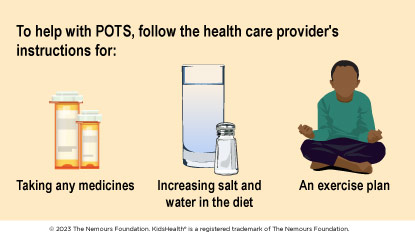People with postural orthostatic tachycardia syndrome (POTS) have an increased heart rate (called tachycardia) when they stand. They may feel lightheaded, tired, and sick to their stomach. They can have other symptoms too. You can do things to help your child if they have POTS symptoms, and they can take steps to make symptoms happen less often.
Follow these instructions to care for your child.


When POTS symptoms happen, your child should:
To make POTS symptoms less likely to happen, help your child avoid triggers that bring symptoms on, such as:
Help your child follow your health care provider's instructions for:

Your child:

What happens in POTS? The autonomic nervous system controls things like heart rate, breathing, and blood pressure. When someone stands, this system tells the blood vessels in the lower body to tighten. This keeps too much blood from going to the lower body to make sure the brain and other parts of the upper body have enough blood. In POTS, this doesn't happen. The heart speeds up to try to get more blood to the brain and upper body but it may not be enough, and this causes the symptoms of POTS. The symptoms may come right after someone stands, or they may take a few minutes to develop.
What are the symptoms of POTS? When someone with POTS stands, their symptoms can include:
What causes POTS? The exact cause is not known. It can develop:
There may be a genetic (inherited) link as POTS is more common in kids whose parents have had it.